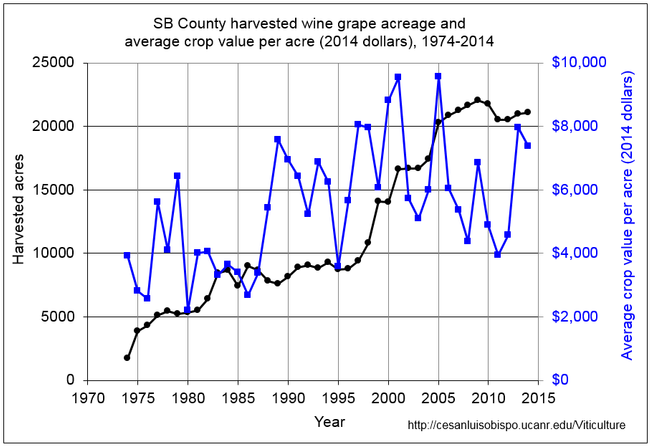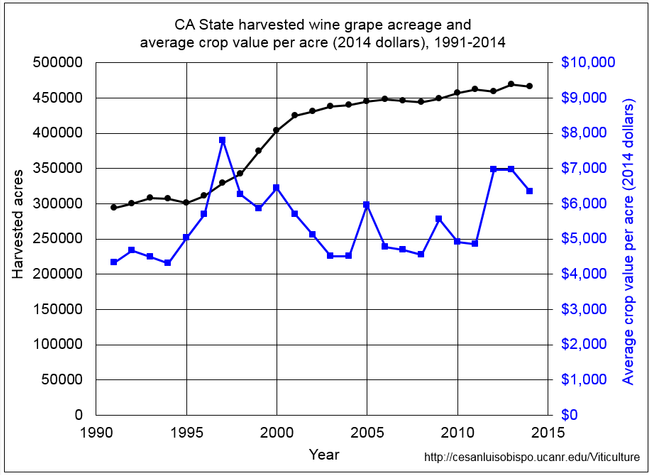- Author: Mark Battany
The previous blog post looked at the historical trends for San Luis Obispo County wine grape production; this post makes a similar evaluation for Santa Barbara County, and provides comparisons to statewide averages.
The following three figures represent data for all of SB County; the raw data is sourced from the SB County Ag Commissioner's Crop Reports. An inflation adjustment is made with the CPI from the US Dept. of Labor. Adjusting the earlier-year dollar values for inflation allows for more meaningful comparison of crop values over time.
The SB County wine grape acreage increased steadily from the early 1970s until the mid 1990s, after which time the acreage increased much more rapidly, approximately doubling in the following decade up to the mid 2000s (Figure 1). This rate of increase in harvested acreage was not as strong as that observed in SLO County, which had tripled during the same period. Average crop values per acre (adjusted for inflation and expressed as 2014 dollars) have not followed the more obvious cycles as were observed in SLO County from the mid-1970s through 1990s, but the broader trends are similar, with generally higher per-acre crop values from the late 1980s through early 2000s and generally lower per-acre crop values for the decade that began in the early 2000s.
While the total harvested wine grape acreage in the state had essentially stopped increasing by 2005, SB County was unusually impacted by the release of the movie Sideways in October 2004. The popularity of this movie and the resulting increased demand for SB County wines likely contributed to the continued growth in acreage for the next several years. The SB County crop values per acre were trending lower overall from 2002 through 2012, except for the very heavily cropped 2005 season; this season saw heavy crops statewide, but SB County growers may have had even more incentive to retain larger crops given the impact of Sideways on demand for local fruit. The 2013 and 2014 seasons have seen a relatively strong recovery in per-acre crop values in the county.
Wine grape crop tonnages per acre increased steadily from the mid-1970s until the present day, now averaging nearly four tons per acre (Figure 2).
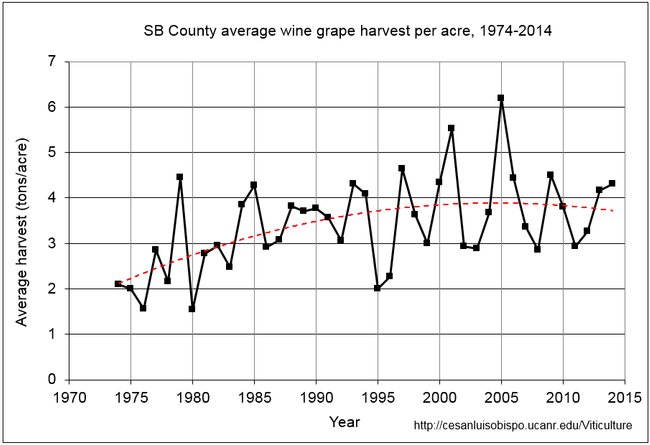
Per-ton wine grape prices in SB County have followed roughly the same overall patterns as were observed in SLO County, while having several hundred dollars higher value per ton on average over time (Figure 3). The higher per-acre crop values of the past two seasons are the result of the combination of above-average production levels (Figure 2) and increased prices per ton (Figure 3).
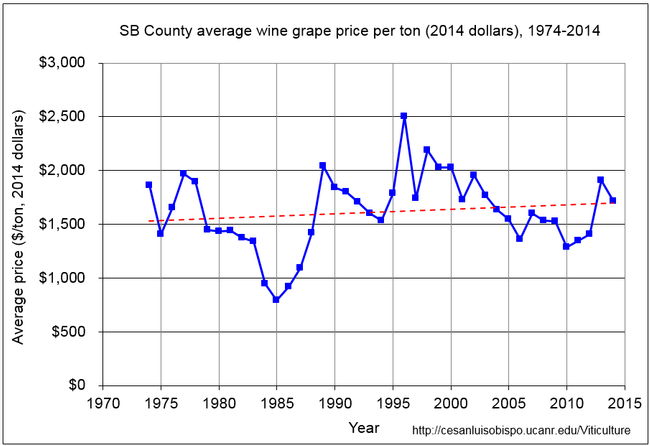
To put both the SB County and SLO County historical production data into perspective, it can be useful to compare to similar data for wine grape production for the state as a whole. The data for the following four charts has been sourced from the NASS Grape Acreage Reports and the NASS Grape Crush Reports to show trends from 1991 through 2014 for California wine grapes.*
Harvested wine grape acreage in the state increased by 50% in the decade from 1995 to 2005, but has increased only slightly since then (Figure 4). Following the high per-acre crop values in the late 1990s, values were relatively low from 2002 through 2011, making that a challenging decade for many growers in the state. However the last three seasons have seen the average per-acre crop value increase substantially in the state. SB County producers have seen a similar rebound in per-acre crop values, while SLO County producers have not yet so far.
The average harvested wine grape tonnage per acre in the state has been trending gradually higher since 1991 (Figure 5). The 2012-2014 seasons saw above-average harvest levels overall in the state.
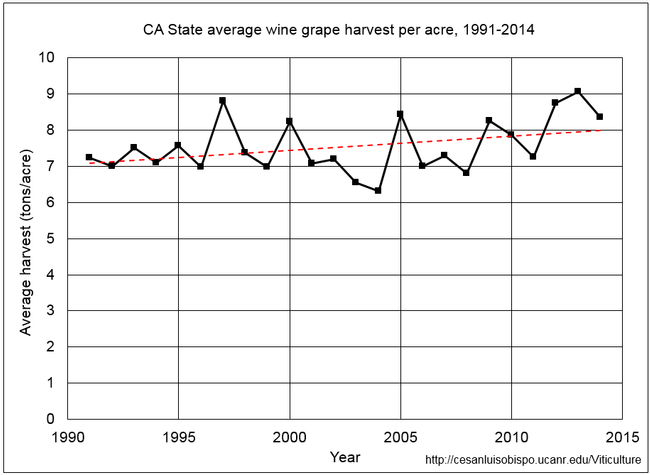
The statewide inflation-adjusted price per ton peaked in 1997, and then gradually declined until 2010 (Figure 6). The price per ton has increased since that time, with the past three seasons being above the trend line. Thus the higher per-acre crop values of the past three seasons statewide have been due to both increased tonnages per acre and increased prices per ton.
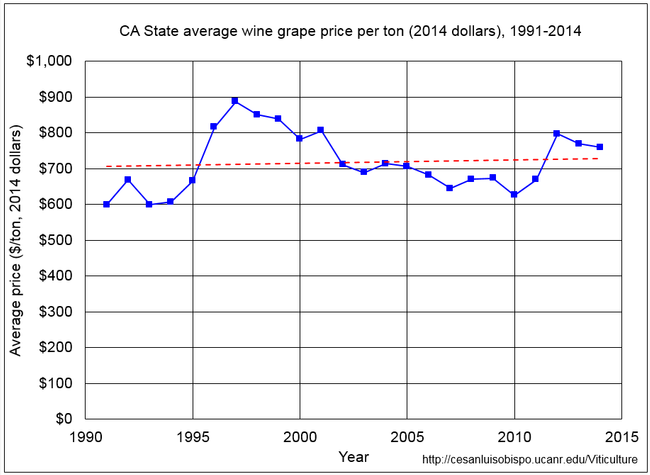
The relationship between bearing (harvested) wine grape acreage and non-bearing acreage in the state also shows how strong the planting boom of the late 1990s and early 2000s was overall (Figure 7). The current relatively low percentage of non-bearing acreage suggests that the total harvested wine grape acreage statewide will not increase markedly in the near future.
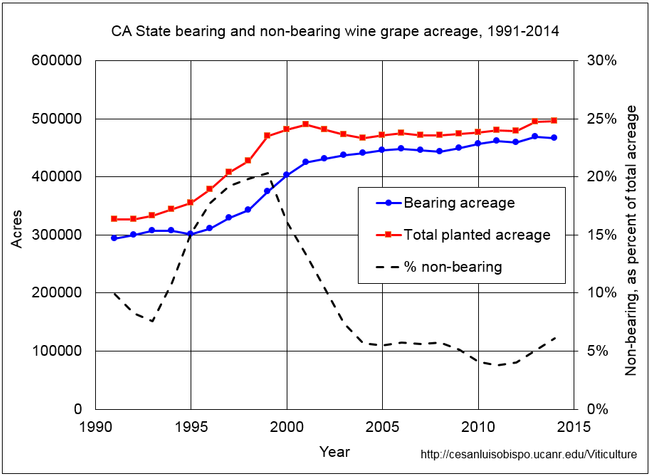
* Calculations do not include raisin and table grape types that were crushed.
For the NASS Grape Acreage Reports, data is from Table 10, "All Wine Type Grapes"
For the NASS Grape Crush Report, data is from the 2014 Grape Crush Report Overview, page 2, chart labeled "California Grape Crush Tonnage and Price, 1988-2013, using the column labeled "Total Wine Type" (note that this chart is mislabeled; it contains data from 1989-2014).


